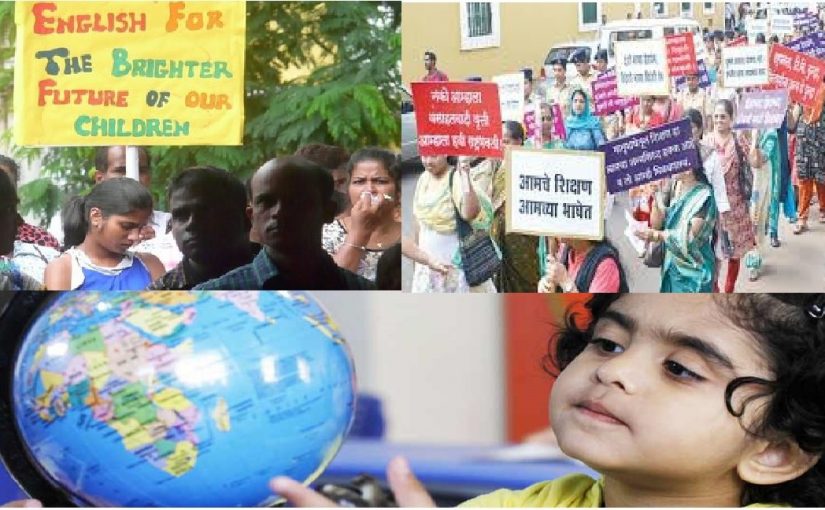FREEDOM: Over two lakh parents have demanded freedom of choice, which effectively means they want grants for all English medium private primary schools
The Goa School Education (amendment) Bill which was supposed to formalise the Medium of Instruction (MoI) policy has lapsed. Over two lakh parents submitted a memo demanding extension of grants to all English medium private primary schools. Over 60 per cent of the 80,000 students at the primary level have switched to English as the medium of instruction
By Rajan Narayan
IN A classic case of twisting the facts, a section of the press has claimed that the number of students enrolled in Konkani and Marathi primary schools is higher than those enrolled in English medium primary schools run by the church. What the figures put out by the education department and the misleading headline fail to reveal is that of the 93,860 students enrolled in primary schools over 60 per cent have opted for the English medium schools. While it may be true that the total number of students studying in government and primary Konkani and Marathi medium schools (37,245) may be higher than the number of students studying in aided English medium primary schools run by the church (31,811), the total number of students in English medium primary schools is significantly higher than those enrolled in vernacular medium government and primary schools.
MAJORITY CHOICE
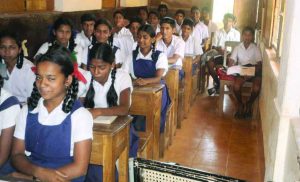
THE Goa state government is refusing to accept the harsh ground reality that the majority of Goans irrespective of caste community and even whether they are niz goenkars or migrants prefer to admit their children to English medium primary schools even if they have to pay high fees every month. In addition to the 31,811 students enrolled in aided primary schools run by the church almost an equal number (30,000) are enrolled in unaided private primary English schools paying fees ranging from `500 to `1000 per month.
Many more, indeed 90 per cent if not 100 per cent of the students enrolled in Konkani and Marathi medium schools, would have shifted to the English medium if grants had been extended to all English medium primary schools instead of only the 127 English primary schools run by the church.
This is clear from the fact that over 30,000 students (as against the 24,704 claimed by the department) have enrolled in English medium primary schools even though they have to pay hefty fees as non-church run primary schools do not get grants from the state government. The grants are limited only to English medium schools run by church organisations.
The state government and particularly the Department of Education has repeatedly admitted that enrolment in vernacular medium schools has been steadily falling. According to government statistics there are more than 900 vernacular primary medium schools which are fully funded by the government. The overwhelming majority of them are Marathi medium primary schools.
The latest government figures highlighted by a section of the press admits that the number of students in Marathi medium schools, both government and aided is 31,307 as against only 6,208 in Konkani medium primary schools. Which means that less than 10 per cent of the total number of students enrolled in primary schools study the official language of the state.
MONEY DOWN THE DRAIN
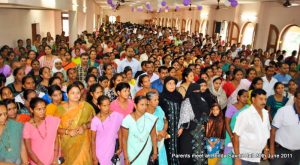
WHAT is overlooked is the huge expense borne by the tax payer to keep the government and even many Konkani medium primary schools on the ventilator. The cost is several hundred times the amount spent by the government on the St Andre MLA, Vishnu Wagh. The economics of keeping vernacular medium schools, particularly Marathi schools which is not even the official language is an appalling. Over 800 government Marathi schools have a total enrolment of just 19,294.
Which means that the average enrolment in a Marathi medium Marathi school is as low as only 24 for all the classes from 1 to 4 whereas it should have been a minimum of hundred. The aided Catholic schools and the unaided schools which teach English have an average class strength of over 30 to 35 per class or 120 (assuming 4 divisions) from 1st to 4th standard. Moreover many of the church schools have been forced to set up additional divisions at the primary level to accommodate the demand for education in the English medium.
The government spends over `5000 crore to keep the 800 odd Marathi school alive despite the very poor enrolment. Most of the government primary schools, both Marathi and Konkani, function from hired premises for which rent has to be paid. Unlike in the case of the private English medium primary schools where the staff are on contract, in government primary schools the official scales have to be paid which are four times the salary paid in unaided private English schools. But even in many Marathi and Konkani government and private primary schools the teachers are on contract as you required at least a diploma in education to be eligible for government scales. As against the 800 schools which cater to 19,295 Marathi medium schools, just 127 church schools meet the educational needs of over 30,000 students.
There are many Marathi medium schools which do not have 10 students spread across four classes. This is also true of many Konkani medium government private schools.
Significantly the enrolment is much higher in aided Kannada and Urdu medium private primary schools. Indeed over the last decade the number of government and primary schools in Kannada and Urdu are growing faster than Konkani medium schools. This is the impact of the mass migration from Karnataka and Muslims from Gujarat and other state in the country who feel safest in Goa.
MIGRANTS CHOOSE ENGLISH
BUT on the other hand even the migrants in Goa given a choice prefer to admit their children in English medium schools. Our own Karnataka migrant maid has admitted both her children to a private schools in Taleigao paying fees of `800 each besides the cost of the tuitions as neither she nor her husband were literate in English. Goa is probably the only state in country where even migrant labour can send their children to English medium primary schools even if they have to pay fees as the wages of migrant labour is highest in the country. As against an average of less than 100 per day and `300 under the National Rural Employment guarantee scheme, a migrant worker in Goa can demand and get between `500 and `800 per day.
Besides the poor enrolment the quality of education in the vernacular primary schools, particularly the Marathi medium schools is very poor. Many of these 800 odd schools are single teacher schools. Which means there is only one teacher to teach all the subjects in all the classes from 1 to 4. The norm set by the human recourses development ministry is that there should be a qualified teacher for each class at the primary level. The burden on the single teachers has been increased following the decision of the government to make English compulsory in Marathi and Konkani medium government and aided primary schools. Most of the teachers in the schools are as innocent of English as the teachers in the diocesan school were ignorant of Devanagari Konkani when they were forced to shift from the English medium to the Devanagari medium in 1993 when the late Sashikala Kakodkar was the chief minister. Of course most of the church schools continued to teach in English or Konklish though there were suppose to teach in the Devanagari Konkani medium.

The worst part of the education system in Goa is the sudden shift in the medium of instruction from Konkani or Marathi to English at the 5th standard. Many students were not able to cope with the sudden shift from Konkani and Marathi medium. This is probably responsible for the huge drop out at the middle schools and higher secondary levels. In fact not even 20 per cent of the students who enrol in the 1st standard manage to reach the higher secondary level. As against the total number of schools at the primary level of 1,252 with an enrolment of 99,607, the numbers at the middle school level from class V to VII are 438 and 66,450 respectively. By the time they reach the secondary level the number of schools declines to 375 and the enrolment falls to less than 30,000.
INCENTIVES
THE state government has tried to sweeten the incentive for enrolling in vernacular schools by including English as a subject from class one itself. Moreover schools imparting education in the Marathi/Konkani medium have to teach English as a compulsory subject up to SSC. Conversely English medium primary schools whether aided or not have to teach Marathi or Konkani up to the 10th standard.
A special incentive of `400 per student per month has been introduce by the government to encourage private institutions to start Konkani and Marathi schools. Indeed due to the poor enrolment there is even a move to hand over the government vernacular Marathi and Konkani schools to private organisations.
FORCE FOR ENGLISH
RECENTLY the Forum for Rights of Children to Education (FORCE), an organisation of parents fighting for freedom of choose on the MoI, submitted 2 lakh signatures petitioning for extension of grants to all English medium schools. Or at least giving parents a choice to decide on the medium of instruction. At the moment parents of poor children have no choice but to admit children to vernacular medium schools which do not charge fees because they are fully funded by the government. Perhaps the even bigger attraction (despite the danger of lizards) is the mid day meal scheme. Unfortunately most parents, including parents of the Marathi manus and the Konkani vadi believe that English is the best passport to a good job for their children.
Many states in the country extend grants to English medium primary schools. Even in BJP ruled states where many schools, for instant in Mumbai, are run by the corporation, English is the MoI. In West Bengal English has been made the MoI with the stipulation that Bengali will be a compulsory subject till the 10th standard. Which was the standard education policy more than 60 years ago when I did my schooling. English was the MoI in all schools with the local language being compulsory till the 10 standard.
The dilemma facing Manohar Parrikar is that he had promised the Rashtriya Swayamsevak Sangh (RSS) that he would withdraw grants to English medium schools. Parrikar, before he got re-elected in 2017 insisted the MoI should be the mother tongue. This is also the policy of the Sangh Parivar. Even more worrying for Goans and those in the south is insistence that Hindi should be made the official language throughout the country. This is an action replay of the decision of the then central government to impose Hindi on the whole country including the south in the 60s. In the face of strong opposition from the southern states of Tamil Nadu, Andhra, Karnataka and Kerala the move was dropped. It is now sought to be revived by Narendra Modi.
The immediate problem in Goa is whether grants should continue to be given to English primary medium schools built by the church. There is stiff opposition from the Sangh Parivar to the continuation of grants to the 127 primary level English medium schools.
BBSM THREAT
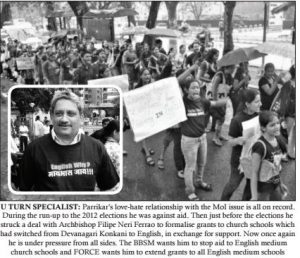 IT MAY be recalled that the RSS chief Subhash Velingkar had quit and contested against the BJP in the 2017 election. Though the Bharatiya Bhasha Suraksha Manch (BBSM) of Velingkar did not get any seats, it damaged the prospects of the BJP, which got only 13 seats. Parrikar has also been accused of a U turn, as before the 2012 election he had supported the agitation against grants for church schools.
IT MAY be recalled that the RSS chief Subhash Velingkar had quit and contested against the BJP in the 2017 election. Though the Bharatiya Bhasha Suraksha Manch (BBSM) of Velingkar did not get any seats, it damaged the prospects of the BJP, which got only 13 seats. Parrikar has also been accused of a U turn, as before the 2012 election he had supported the agitation against grants for church schools.
Unfortunately for Parrikar all the Catholic candidates fielded by the BJP won the 2012 election and seven of the 13 MLAs elected in 2017 are Catholics. Parrikar is in no position to antagonize the Catholics as they represent the majority. There is of course no possibility of the Sangh Parivar permitting a Catholic to become the chief minister. Which is why Parrikar is trying to split the Congress party and get Vishwajit and others to join him so that he will not be dependent on the Catholic MLAs.
CATERPILLARS OF EDUCATION
GIVEN the poor standards it is not surprising that Goan students are not pillars of Goa but caterpillars. But it is not the fault of the students. The present generation of students is reaping the bitter harvest of the neglect of education by the Portuguese colonial regime. Until 1961, you could only study up to the equivalent of the 8th standard, and that too only in Portuguese. Though there were some Marathi schools, these were set up by big landlords for the benefit of their own children, and Konkani schools were deliberately suppressed by the Portuguese.
There was no question of higher studies in Goa for students before liberation. There was not a single arts or science college in Goa before liberation, and forget about engineering colleges, there were not even industrial training institutes or polytechnics. The only exception was the medical school which was set up by the Portuguese in 1860 — not for the benefit of Goans, but because they needed doctors for huge Portuguese colonies in Africa, like Angola. So much so, that any Goan who wanted to pursue higher studies had to go to Mumbai or to Dharwad in Karnataka.
This created a great crisis when Goa was liberated. Most of the Portuguese technical staff like engineers left. There was no one to look after the water supply and the electricity departments. This lead to mass migration and recruitment of engineers from Maharashtra and Karnataka on deputation who never went back. Even now the senior positions in the PWD and the Electricity Department are occupied by people from Karnataka Maharashtra and Kerala. The irony is that now Goa has six engineering colleges but no jobs to offer, with the result that all the graduates move out of Goa in search of jobs. The first degree colleges in Goa were set up by Dempos’s in 1963 followed by the Chowgules. For some strange reason, two law colleges were also set up — one by V.M Salgaocar and the other by Ramnath Kare. As of May 2017, on the eve of the new academic year, there were 24 arts and science colleges and five engineering colleges in the state.
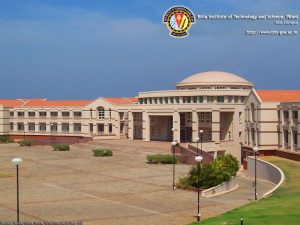 The quality of education continues to be poor, not only at the college level but at the university level also. It was recently revealed that in most science subjects the pass percentage in the university is less than 25 per cent. This is primarily because of the quality of teaching. Most of the colleges rely on contract teachers. It is bad enough to employ teachers on monthly contracts, some of the best colleges even hire teachers on a per-lecture basis. Teachers hired on contract have no interest in teaching or interest in the students as they are worried about job security. This is absurd as after revision of salaries by the UGC a lecturer at the starting of the scale can expect to get a gross salary of `40,000 and a professor get more than `1 lakh. The catch is that to qualify for the UGC scales candidates have to complete the national eligibility test or have a M.Phil degree. Most of Goa’s college teachers do not have the required qualifications.
The quality of education continues to be poor, not only at the college level but at the university level also. It was recently revealed that in most science subjects the pass percentage in the university is less than 25 per cent. This is primarily because of the quality of teaching. Most of the colleges rely on contract teachers. It is bad enough to employ teachers on monthly contracts, some of the best colleges even hire teachers on a per-lecture basis. Teachers hired on contract have no interest in teaching or interest in the students as they are worried about job security. This is absurd as after revision of salaries by the UGC a lecturer at the starting of the scale can expect to get a gross salary of `40,000 and a professor get more than `1 lakh. The catch is that to qualify for the UGC scales candidates have to complete the national eligibility test or have a M.Phil degree. Most of Goa’s college teachers do not have the required qualifications.
The biggest rackets are the self-financing courses which unlike the BA, BSC and Bcom courses do not get any grants from the government. Students have to pay huge fees as the colleges have to meet all their expenses, including teachers’ salaries, from the fees. The most popular of the self-financed courses are the BBA, BCA and the multimedia undergraduate courses. Everyone right from the course co-ordinators to the lecturers, are on a contract basis. The quality of teaching is so bad compared to the fees charged, that apparently this year nobody wants to join the courses.
Goa is blessed with the Birla Institute of Technology and it also has a National Institute of Technology. From this year Goa even has an ITI. Goa also has the Goa Institute of Management (GIM). Unfortunately very few Goan students secure admission to these colleges because there are no reservations and admission is only by merit. Not surprisingly even for outside students the Goa campus of BITS is the last choice because parents are afraid of Goa’s reputation as a paradise for drugs and daaru.
